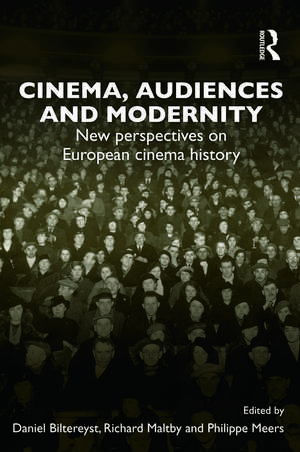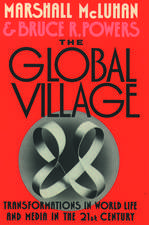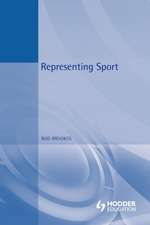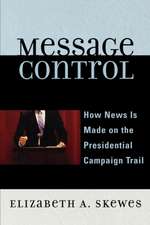Cinema, Audiences and Modernity: New perspectives on European cinema history
Editat de Daniel Biltereyst, Richard Maltby, Philippe Meersen Limba Engleză Paperback – 5 sep 2011
The book provides a wide range of research methodologies and perspectives on these matters, including:
- the use of oral history methods
- questionnaires
- diaries
- audience letters
- as well as industrial, sociological and other accounts on historical film audiences.
The volume is part of a ‘new cinema history’ effort within film and screen studies to look at film history not only as a history of production, textual relations or movies-as-artefacts, but rather to concentrate more on the receiving end, the social experience of cinema, and the engagement of film/cinema (history) ‘from below’. The contributions to the volume reflect upon the very different ways in which cinema has been accepted, rejected or disciplined as an agent of modernity in neighbouring parts of Europe, and how cinema-going has been promoted and regulated as a popular social practice at different times in twentieth-century European history.
| Toate formatele și edițiile | Preț | Express |
|---|---|---|
| Paperback (1) | 355.20 lei 6-8 săpt. | |
| Taylor & Francis – 5 sep 2011 | 355.20 lei 6-8 săpt. | |
| Hardback (1) | 1005.04 lei 6-8 săpt. | |
| Taylor & Francis – 2 sep 2011 | 1005.04 lei 6-8 săpt. |
Preț: 355.20 lei
Nou
Puncte Express: 533
Preț estimativ în valută:
67.97€ • 70.82$ • 56.28£
67.97€ • 70.82$ • 56.28£
Carte tipărită la comandă
Livrare economică 03-17 aprilie
Preluare comenzi: 021 569.72.76
Specificații
ISBN-13: 9780415672788
ISBN-10: 0415672783
Pagini: 232
Ilustrații: 18 b/w images and 14 tables
Dimensiuni: 156 x 234 x 233 mm
Greutate: 0.33 kg
Ediția:New.
Editura: Taylor & Francis
Colecția Routledge
Locul publicării:Oxford, United Kingdom
ISBN-10: 0415672783
Pagini: 232
Ilustrații: 18 b/w images and 14 tables
Dimensiuni: 156 x 234 x 233 mm
Greutate: 0.33 kg
Ediția:New.
Editura: Taylor & Francis
Colecția Routledge
Locul publicării:Oxford, United Kingdom
Public țintă
UndergraduateCuprins
Chapter 1. Cinema, audiences and modernity: an introduction Daniel Biltereyst, Richard Maltby and Philippe Meers Part I - Cinema, Tradition and Community Chapter 2. Cinema-going between ideology and commerce: a longitudinal research on rural versus urban cinema in Flanders (1920s-1970s) Philippe Meers, Kathleen Lotze, Lies Van de Vijver and Daniel Biltereyst Chapter 3. Spaces of Early Film Exhibition in Sweden, 1897-1911 Asa Jernudd Chapter 4. Movie-going under Military Occupation, Düsseldorf, 1919 - 1925 Frank Kessler and Sabine Lenk Chapter 5. ‘Christ is coming to the Elite cinema’: Film exhibition in the Catholic South of the Netherlands, 1910s and 1920s Thunnis Van Oort Chapter 6. The Cinematic Shapes of the Socialist Modernity Programme: Ideological and Economic Parameters of Cinema Distribution in the Czech Lands, 1948 - 1970 Pavel Skopal Chapter 7. ‘…The Management Committee intend to act as Ushers’: Cinema Operation and the South Wales Miners’ Institutes in the 1950s and 1960s Stefan Moitra Part II - Audiences, Modernity and Cultural Exchange Chapter 8. Urban legend: Early cinema, modernization, and urbanization in Germany, 1895 - 1914 Annemone Ligensa Chapter 9. ‘Diagnosis: Flimmeritis’: Female Cinema-going in Imperial Germany, 1911 - 1918 Andrea Haller Chapter 10. AFGRUNDEN in Germany: Monopolfilm, Cinema-Going and the Emergence of the Film Star Asta Nielsen, 1910 - 1911 Martin Loiperdinger Chapter 11. ‘Senza Patria’ or without a homeland: Italian war films and immigrants in London, 1914 - 1918 Pierluigi Ercole Chapter 12. Imagining modern Hungary through film: debates on national identity, modernity and cinema in early twentieth century Hungary Ana Manchin Chapter 13. Hollywood in disguise: Practices of exhibition and reception of foreign films in Czechoslovakia in the 1930s Petr Szczepanik
Recenzii
'This volume, edited by experienced and knowledgeable scholars with international reputations, gathers together a fascinating set of essays that, taken together, illuminate the historical relationships among films, moviegoing, and modernity.
The focus of this wide-ranging work is Europe, and the justification for this focus is compelling. The bulk of historical scholarship on the experience of cinema, the social experience of moviegoing, the history of cinematic reception, and movies audiences derives from case studies in the United States, dating back to the 1970s. In the meantime, a new generation of film scholars have turned their attention to the quite different contexts within which films were shown and viewed. Exhibition and moviegoing patterns varied markedly not only between national cinemas but also within particular nations. These differences raise interesting questions about the role of religion, language, cultural difference, gender, and ethnicity in patterns of movie exhibition, distribution, reception, and attendance.
Geographic coverage is admirably broad, setting up possibilities for comparative analysis among a number of nations, regions, and locales. Similarly, the chronological coverage is broad: ranging from the early periods of film history through the post-war period.
This collection fits very well with a growing literature on the history of the experience of cinema, and it will add significantly to our knowledge base on the particularities and commonalities of European film culture as viewed from the bottom up.' Robert C. Allen, University of North Carolina at Chapel Hill
'The essays use a range of research methodologies, including oral history, to produce a 'new cinema history' that takes greater account of audience reception and that acknowledges the importance of the audience as consumers of films. (...) This provides thought-provoking insights into the relationshipos bewteen cinema and modernity in different European contexts, and the essays in this volume, of a consistently high standard, span a chronological period from 1895 to 1970. Cinema, Audiences and Modernity is essential reading for those interested in audiences, reception and the social values and cultural history of cinema in the nineteenth and twentieth century.' Helen Rajabi, European Review of History, 19(4), August 2012
'(the essays) represent an exciting stage in the disciplinary development of what the editors call 'new cinema history'. (...) This work has a sense of actuality and urgency that is remarkable given its historical nature. (The book) combine(s) careful and intelligent editing with the vibrancy of a work in progress. The pose is impeccable and the chapters resonate with each other with no jarring shifts in register. With technological changes making collaborative, scalable projects an increasingly frequent form of scholarly practice, the (book) reviewed set(s) a high standard for a field that is evidently thriving.' Maria A. Vélez-Serna, Historical Journal of Film, Radio & Television, 32(3), September 2012
'...Biltereyst, Maltby, and Meers volumes have a legitimate claim to providing perhaps the most varied comparative data available to date. In doing so, they also counter accusations of provincialism within individual studies, for they begin to establish a potentially global and transhistorical mapping of cinema exhibition.' Joe Kember, Early Popular Visual Culture
'Biltereyst, Maltby and Meers' edited collection in the end manages to expand...the boundaries of what we understand as modernity, its relationship and association to cinema; in addition, and more importantly perhaps, it stretches the historiographical map of Early European Cinema research towards territories and methodologies not yet common.' Tonia Zakakopoulou, Participations: Journal of Audience & Reception Studies
The focus of this wide-ranging work is Europe, and the justification for this focus is compelling. The bulk of historical scholarship on the experience of cinema, the social experience of moviegoing, the history of cinematic reception, and movies audiences derives from case studies in the United States, dating back to the 1970s. In the meantime, a new generation of film scholars have turned their attention to the quite different contexts within which films were shown and viewed. Exhibition and moviegoing patterns varied markedly not only between national cinemas but also within particular nations. These differences raise interesting questions about the role of religion, language, cultural difference, gender, and ethnicity in patterns of movie exhibition, distribution, reception, and attendance.
Geographic coverage is admirably broad, setting up possibilities for comparative analysis among a number of nations, regions, and locales. Similarly, the chronological coverage is broad: ranging from the early periods of film history through the post-war period.
This collection fits very well with a growing literature on the history of the experience of cinema, and it will add significantly to our knowledge base on the particularities and commonalities of European film culture as viewed from the bottom up.' Robert C. Allen, University of North Carolina at Chapel Hill
'The essays use a range of research methodologies, including oral history, to produce a 'new cinema history' that takes greater account of audience reception and that acknowledges the importance of the audience as consumers of films. (...) This provides thought-provoking insights into the relationshipos bewteen cinema and modernity in different European contexts, and the essays in this volume, of a consistently high standard, span a chronological period from 1895 to 1970. Cinema, Audiences and Modernity is essential reading for those interested in audiences, reception and the social values and cultural history of cinema in the nineteenth and twentieth century.' Helen Rajabi, European Review of History, 19(4), August 2012
'(the essays) represent an exciting stage in the disciplinary development of what the editors call 'new cinema history'. (...) This work has a sense of actuality and urgency that is remarkable given its historical nature. (The book) combine(s) careful and intelligent editing with the vibrancy of a work in progress. The pose is impeccable and the chapters resonate with each other with no jarring shifts in register. With technological changes making collaborative, scalable projects an increasingly frequent form of scholarly practice, the (book) reviewed set(s) a high standard for a field that is evidently thriving.' Maria A. Vélez-Serna, Historical Journal of Film, Radio & Television, 32(3), September 2012
'...Biltereyst, Maltby, and Meers volumes have a legitimate claim to providing perhaps the most varied comparative data available to date. In doing so, they also counter accusations of provincialism within individual studies, for they begin to establish a potentially global and transhistorical mapping of cinema exhibition.' Joe Kember, Early Popular Visual Culture
'Biltereyst, Maltby and Meers' edited collection in the end manages to expand...the boundaries of what we understand as modernity, its relationship and association to cinema; in addition, and more importantly perhaps, it stretches the historiographical map of Early European Cinema research towards territories and methodologies not yet common.' Tonia Zakakopoulou, Participations: Journal of Audience & Reception Studies
Descriere
This book confronts theoretical models on cinema as both a product and a catalyst of European modernity with new empirical work on the history of the social experience of cinema-going, film audiences and film exhibition.













